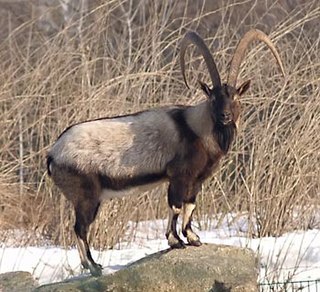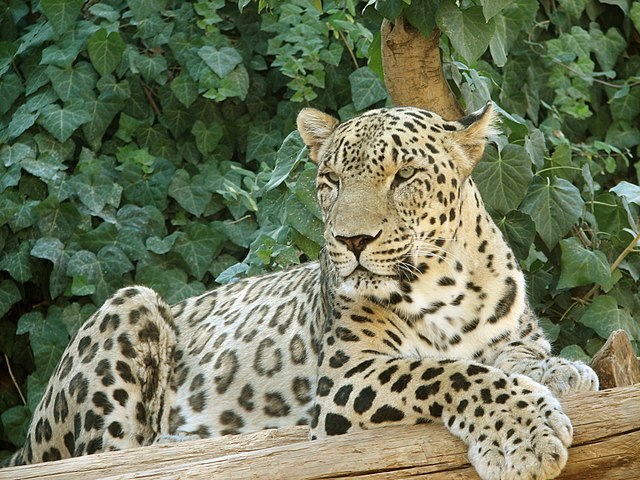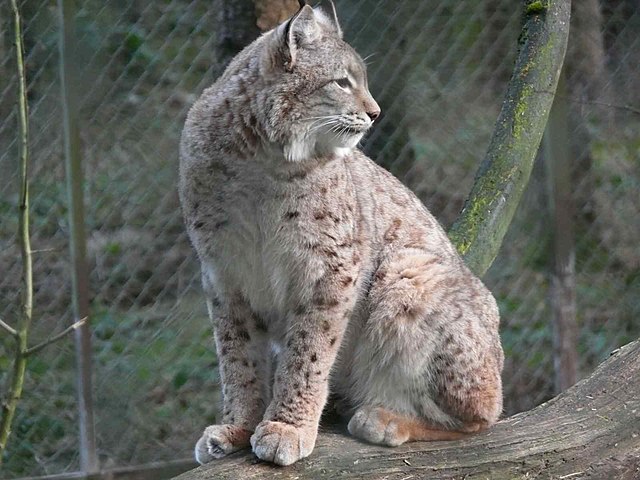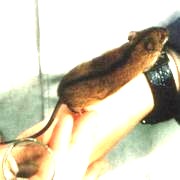Top Qs
Timeline
Chat
Perspective
List of mammals of Armenia
From Wikipedia, the free encyclopedia
Remove ads
There are sixty-two mammal species in Armenia, of which one is critically endangered, two are endangered, eight are vulnerable, and four are near threatened.[1]
The following tags are used to highlight each species' conservation status as assessed by the International Union for Conservation of Nature:
| EX | Extinct | No reasonable doubt that the last individual has died. |
| EW | Extinct in the wild | Known only to survive in captivity or as a naturalized populations well outside its previous range. |
| CR | Critically endangered | The species is in imminent risk of extinction in the wild. |
| EN | Endangered | The species is facing an extremely high risk of extinction in the wild. |
| VU | Vulnerable | The species is facing a high risk of extinction in the wild. |
| NT | Near threatened | The species does not meet any of the criteria that would categorise it as risking extinction but it is likely to do so in the future. |
| LC | Least concern | There are no current identifiable risks to the species. |
| DD | Data deficient | There is inadequate information to make an assessment of the risks to this species. |
Remove ads
Order: Artiodactyla (even-toed ungulates)



The even-toed ungulates are ungulates whose weight is borne about equally by the third and fourth toes, rather than mostly or entirely by the third as in perissodactyls. There are about 220 artiodactyl species, including many that are of great economic importance to humans.
Remove ads
Order: Carnivora (carnivorans)
Summarize
Perspective






There are over 260 species of carnivorans, the majority of which feed primarily on meat. They have a characteristic skull shape and dentition.
- Suborder: Feliformia
- Family: Felidae (cats)
- Subfamily: Felinae
- Genus: Felis
- Jungle cat, F. chaus LC[9]
- African wildcat, F. lybica LC[10]
- Genus: Lynx
- Eurasian lynx, L. lynx LC[11]
- Caucasian lynx, L. l. dinniki
- Eurasian lynx, L. lynx LC[11]
- Genus: Otocolobus
- Pallas's cat, O. manul LC possibly extirpated[12]
- Genus: Felis
- Subfamily: Pantherinae
- Genus: Panthera
- Leopard, P. pardus VU[13]
- Persian leopard, P. p. tulliana EN[13]
- Leopard, P. pardus VU[13]
- Genus: Panthera
- Subfamily: Felinae
- Family: Hyaenidae (hyaenas)
- Genus: Hyaena
- Striped hyena, H. hyaena NT[14]
- Genus: Hyaena
- Family: Felidae (cats)
- Suborder: Caniformia
- Family: Canidae (dogs, foxes)
- Genus: Canis
- Golden jackal, C. aureus LC[15]
- European jackal, C. a. moreoticus
- Gray wolf, C. lupus LC[16]
- Steppe wolf, C. l. campestris
- Golden jackal, C. aureus LC[15]
- Genus: Vulpes
- Genus: Canis
- Family: Ursidae (bears)
- Genus: Ursus
- Brown bear, U. arctos LC[18]
- Eurasian brown bear, U. a. arctos
- Brown bear, U. arctos LC[18]
- Genus: Ursus
- Family: Mustelidae (mustelids)
- Genus: Lutra
- Eurasian otter, L. lutra NT[19]
- Genus: Martes
- Beech marten, M. foina LC[20]
- European pine marten, M. martes LC[21]
- Genus: Meles
- Caucasian badger, M. canescens NE
- Genus: Mustela
- Least weasel, M. nivalis LC[22]
- Genus: Vormela
- Marbled polecat, V. peregusna VU[23]
- Genus: Lutra
- Family: Canidae (dogs, foxes)
Remove ads
Order: Chiroptera (bats)

The bats' most distinguishing feature is that their forelimbs are developed as wings, making them the only mammals capable of flight. Bat species account for about 20% of all mammals.
- Family: Vespertilionidae
- Subfamily: Myotinae
- Genus: Myotis
- Geoffroy's bat, M. emarginatus LC[24]
- Whiskered bat, M. mystacinus LC[25]
- Natterer's bat, M. nattereri LC[26]
- Schaub's myotis, M. schaubi DD[27]
- Genus: Myotis
- Subfamily: Vespertilioninae
- Genus: Barbastella
- Western barbastelle, B. barbastellus NT[28]
- Genus: Nyctalus
- Greater noctule bat, N. lasiopterus NT[29]
- Lesser noctule, N. leisleri LC[30]
- Genus: Barbastella
- Subfamily: Miniopterinae
- Genus: Miniopterus
- Common bent-wing bat, M. schreibersii VU[31]
- Genus: Miniopterus
- Subfamily: Myotinae
- Family: Rhinolophidae
- Subfamily: Rhinolophinae
- Genus: Rhinolophus
- Blasius's horseshoe bat, R. blasii LC[32]
- Mediterranean horseshoe bat, R. euryale NT[33]
- Greater horseshoe bat, R. ferrumequinum LC[34]
- Lesser horseshoe bat, R. hipposideros LC[35]
- Mehely's horseshoe bat, R. mehelyi VU[36]
- Genus: Rhinolophus
- Subfamily: Rhinolophinae
Order: Erinaceomorpha (hedgehogs and gymnures)
The order Erinaceomorpha contains a single family, Erinaceidae, which comprise the hedgehogs and gymnures. The hedgehogs are easily recognised by their spines while gymnures look more like large rats.
- Family: Erinaceidae (hedgehogs)
- Subfamily: Erinaceinae
- Genus: Erinaceus
- Southern white-breasted hedgehog, E. concolor LC
- Genus: Erinaceus
- Subfamily: Erinaceinae
Order: Lagomorpha (lagomorphs)

The lagomorphs comprise two families, Leporidae (hares and rabbits), and Ochotonidae (pikas). Though they can resemble rodents, and were classified as a superfamily in that order until the early 20th century, they have since been considered a separate order. They differ from rodents in a number of physical characteristics, such as having four incisors in the upper jaw rather than two.
- Family: Leporidae
- Genus: Lepus
- European hare, L. europaeus LC[37]
- Genus: Lepus
Remove ads
Order: Rodentia (rodents)
Summarize
Perspective


Rodents make up the largest order of mammals, with over 40% of mammalian species. They have two incisors in the upper and lower jaw which grow continually and must be kept short by gnawing. Most rodents are small though the capybara can weigh up to 45 kg (100 lb).
- Suborder: Hystricomorpha
- Family: Hystricidae (Old World porcupines)
- Genus: Hystrix
- Indian crested porcupine, H. indica LC[38]
- Genus: Hystrix
- Family: Hystricidae (Old World porcupines)
- Suborder: Sciurognathi
- Family: Sciuridae (squirrels)
- Subfamily: Sciurinae
- Tribe: Sciurini
- Genus: Sciurus
- Caucasian squirrel, S. anomalus NT
- Genus: Sciurus
- Tribe: Sciurini
- Subfamily: Xerinae
- Tribe: Marmotini
- Genus: Marmota
- Long-tailed marmot, M. caudata NT
- Genus: Spermophilus
- Asia Minor ground squirrel, Spermophilus xanthoprymnus
- Genus: Marmota
- Tribe: Marmotini
- Subfamily: Sciurinae
- Family: Gliridae (dormice)
- Subfamily: Glirinae
- Genus: Glis
- European edible dormouse, Glis glis
- Genus: Dryomys
- Forest dormouse, Dryomys nitedula
- Genus: Eliomys
- Garden dormouse, Eliomys quercinus[39]
- Genus: Glis
- Subfamily: Glirinae
- Family: Dipodidae (jerboas)
- Subfamily: Allactaginae
- Genus: Allactaga
- Small five-toed jerboa, Allactaga elater
- Genus: Allactaga
- Subfamily: Sicistinae
- Genus: Sicista
- Armenian birch mouse, S. armenica CR[40]
- Genus: Sicista
- Subfamily: Allactaginae
- Family: Spalacidae
- Subfamily: Spalacinae
- Genus: Nannospalax
- Nehring's blind mole-rat, Nannospalax nehringi
- Genus: Nannospalax
- Subfamily: Spalacinae
- Family: Cricetidae
- Subfamily: Cricetinae
- Genus: Mesocricetus
- Turkish hamster, Mesocricetus brandti
- Genus: Mesocricetus
- Subfamily: Arvicolinae
- Genus: Chionomys
- Snow vole, Chionomys nivalis
- Genus: Ellobius
- Transcaucasian mole vole, Ellobius lutescens
- Genus: Microtus
- Altai vole, Microtus obscurus
- Genus: Chionomys
- Subfamily: Cricetinae
- Family: Muridae (mice, rats, voles, gerbils, hamsters, etc.)
- Subfamily: Gerbillinae
- Genus: Meriones
- Dahl's jird, Meriones dahli EN
- Persian jird, Meriones persicus
- Tristram's jird, Meriones tristrami
- Vinogradov's jird, Meriones vinogradovi
- Genus: Meriones
- Subfamily: Murinae
- Genus: Apodemus
- Striped field mouse, Apodemus agrarius
- Yellow-breasted field mouse, Apodemus fulvipectus
- Black Sea field mouse, Apodemus ponticus
- Ural field mouse, Apodemus uralensis
- Genus: Micromys
- Eurasian harvest mouse, Micromys minutus
- Genus: Rattus
- Genus: Apodemus
- Subfamily: Gerbillinae
- Family: Sciuridae (squirrels)
Remove ads
Order: Soricomorpha (shrews, moles, and solenodons)


The Soricomorpha are insectivorous mammals. The shrews and solenodons resemble mice while the moles are stout-bodied burrowers.
- Family: Soricidae (shrews)
- Subfamily: Crocidurinae
- Genus: Crocidura
- Armenian shrew, C. armenica DD
- Gueldenstaedt's shrew, C. gueldenstaedtii LC
- Bicolored shrew, C. leucodon LC
- Lesser white-toothed shrew, C. suaveolens LC[42]
- Genus: Crocidura
- Subfamily: Soricinae
- Tribe: Nectogalini
- Genus: Neomys
- Transcaucasian water shrew, N. teres LC
- Genus: Neomys
- Tribe: Soricini
- Genus: Sorex
- Eurasian pygmy shrew, S. minutus LC
- Radde's shrew, S. raddei LC
- Caucasian pygmy shrew, S. volnuchini LC
- Genus: Sorex
- Tribe: Nectogalini
- Subfamily: Crocidurinae
Remove ads
Locally extinct
The following species are locally extinct in the country:
See also
References
External links
Wikiwand - on
Seamless Wikipedia browsing. On steroids.
Remove ads